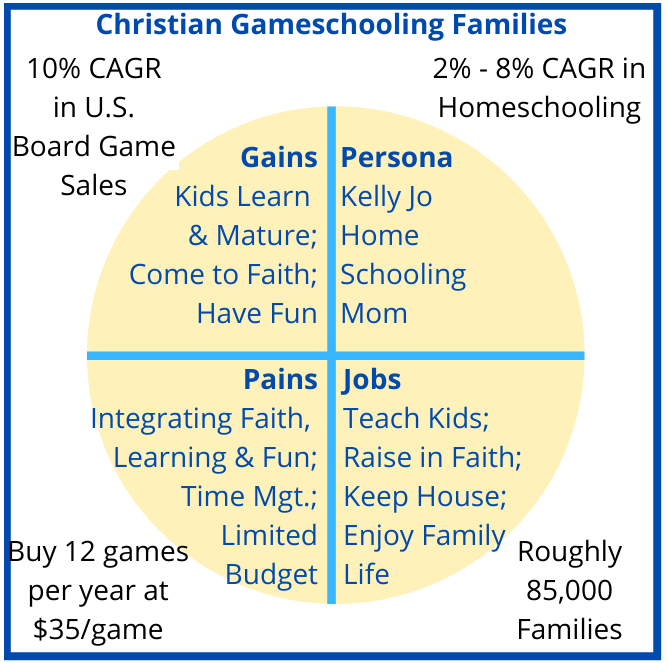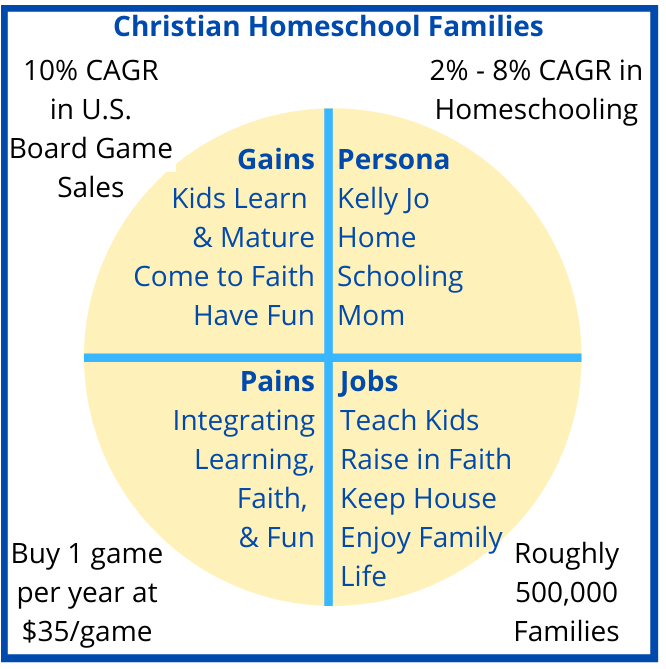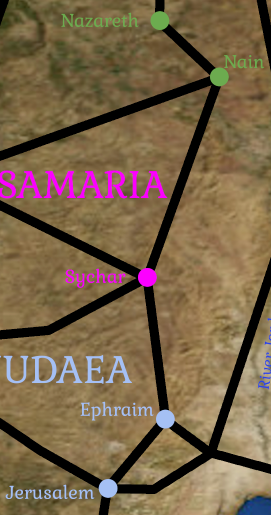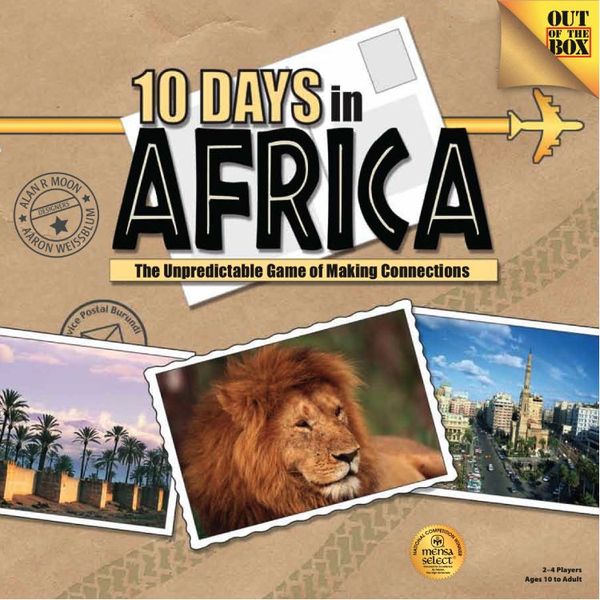A couple of weeks ago I shared with you the Customer Profile I’d developed for the initial target customer persona for SDG Games. Kelly Jo is a (fictional) homeschooling mom with a couple of kids. I developed some hypotheses about the jobs, pains, and gains for this persona. How could I test these hypotheses?
Steve Blank says that the number one goal of customer discovery is “turning the founders’ initial hypotheses about their market and customers into facts.”¹ And the phrase he’s famous for saying in how to do customer discovery is “get out of the building.” Customer discovery is all about spending time with potential customers to deeply understand how they live and work so that your offers truly fit their needs.
For customer discovery to test my hypotheses for SDG Games, I pursued three approaches: an online survey, interviews, and participating in Facebook groups.
For decades, businesses have relied on customer surveys to learn about customer needs and preferences. Surveys can be effective at developing quantitative perspectives on specific clearly defined questions. For example: “36% of CTOs at medium sized enterprises prefer monthly contracts.” Surveys are much less effective for gaining qualitative perspectives, especially on emerging topics. To be effective, a survey also requires a large enough response to provide statistically meaningful results. The response to my survey was not broad enough to draw statistically meaningful results, however, one key takeaway from the results received was that there were additional “pains” that I had failed to reflect in my original hypotheses, specifically the challenge of internal family dynamics. For example, one respondent said “I have multiple children under the age of 5” and then explained how that made it hard to keep their attention for long.
Because of the shortcomings of customer surveys, especially for startups with innovative and unconventional concepts, the Lean startup community has tended to focus more on customer interviews. This is the approach that I most often recommend to startups. So as part of SDG Games’ customer discovery, I spoke with moms who are currently or have previously homeschooled.
Before I explain what I learned, let me describe a customer discovery interview. These interviews are NOT about the product or concept. When you lead a customer discovery interview, very few statements should come out of your mouth, instead, you should almost exclusively ask questions. You are here to listen, not to be heard.
Here’s an example of how my side of an SDG Games customer discovery interview might go:
- Thanks for your time. I really appreciate it. This is all about learning from you, so we aren’t going to talk about my product at all. I’m certainly not trying to sell you anything. If you’re interested in hearing what we’re working on, if we have time, I can certainly give you a quick overview at the end, but let’s really focus on you and your needs totally independent of what I’m working on.
- As a homeschooling mom, how would you describe your job? What is your job description?
- Wow, that’s a lot. Which of those different functions is most important?
- Which takes up most of your time?
- That’s really interesting. When things are going really well in all those different aspects of your job, what does it look like? What are the near term benefits of what you’re doing?
- And when you think longer term, what are the long term blessings of being a homeschooling mom?
- Okay, but I’m guessing things don’t always go great. What are some of the biggest challenges you face in doing your job? What makes it hard?
- Are there specific roadblocks that sometimes makes it feel like it’s impossible for you to be successful in all those things you described as your job?
- Let’s talk about one of those. What have you tried to overcome the time management challenges?
- Did that work?
- Were there aspects of that approach that you thought were really good? What aspects really didn’t work?
- Are there approaches that you’ve thought about but haven’t tried?
- Why didn’t you try it?
- Thank you again for your time and your insights. This has been super helpful to me! Do you have any questions for me?
As you can guess, this doesn’t follow a fixed script, it flows with the conversation, and every conversation is different. At each step in the process, I might probe more to make sure I understand what they are saying, or I might follow a rabbit-trail that they introduce to see if it produces any really insightful perspectives.
Through the customer interviews, I think my hypotheses on the jobs and gains were pretty much confirmed. On the pains, however, I realized that I had missed some that were at least as big as any I’d previously identified. Specifically, time and budget are big issues for most homeschooling moms. Teaching is a lot of work, as is managing a home. Unlike a job or even a traditional classroom, the teacher’s authority is balanced with motherly love, and the students have demands on Mrs. Teacher that go beyond anything a classroom teacher will typically need to address.
Money is also a big deal in most homeschooling families. Parents need to bear the costs of curriculum, books, teaching tools, and materials usually without any kind of government or donor support. Additionally, most homeschooling families are single income households. That typically means that there’s not a lot of money left over for special “treats” like board games.
So, my two main takeaways from the survey and interviews are:
- Do everything possible to reduce the game cost.
- Make sure the game doesn’t take too long to play, or at least that there’s a “fast” option.
Surprising to me, the most valuable perspectives in customer discovery actually came from Facebook. There’s a very active Christian Homeschooling Families group on Facebook with over 45,000 members. Many in this community actively share their lives with each other, looking for input and help on things well beyond the classroom. “NHSR” (not homeschool related) is a very common tag in this group. That gave me a very good perspective into what is really shaping the jobs/gains/pains for these potential customers.
As I’ve studied the discipline of customer discovery, I’ve often come across the concept of “going home” with customers or “a day in the life” of customers. This has always seemed like an optimal situation, but one that is very hard to pull off, and probably impossible to do at any scale. However, this Facebook group gave me an opportunity to glance into the lives of hundreds or thousands of active community participants.
One of my big takeaways from this exercise is that the Christian homeschooling families target market is not as homogenous as I’d represented in the customer profile. There are significant differences based on the ages of kids being homeschooled, the number of kids in the home, and the importance of integrating faith into the educational process. There are also different philosophical approaches to homeschooling with phrases like “unschooling” and “Charlotte Mason method” having specific implications for how families approach homeschooling.
I also discovered a relatively new approach to homeschooling called “gameschooling”. There’s a very active “Gameschooling” group in Facebook with over 31,000 members. This isn’t specifically for Christian families and there’s clearly a mix of Christian and secular homeschoolers, but the “about” for the group starts with “We believe that homeschooling can be *almost* all fun and games!” which is very encouraging for SDG Games’ mission.
Although it’s clear from this community that most of the families are using games as a relatively minor part of their overall education, these families are clearly much more likely to consider buying an educational game than the broader homeschooling population. From some specific posts and general comments in both Facebook groups, I would estimate that the typical Christian homeschooling family might buy one game a year, while the typical gameschooling family might buy one game each month.
From this observation, it seems like we should narrow our initial focus a bit further to Christian Gameschooling Families. In my previous article I identified the market of Christian Homeschooling Families at 200,000 to 1 million. Using the Facebook group size numbers (and an estimate that 20% of the members of the Gameschooling group are Christians), I would estimate there are approximately 30,000–150,000 Christian Gameschooling Families in the U.S., which is still a large enough market to initially target.
With all that in mind, above is an updated version of our Customer Profile.
My time on Facebook also was encouraging in terms of the direction of our first game. On January 2 of this year one member of the Christian Homeschooling Families group posted: “Looking for recommendations for family games (not electronic, but board games etc). My children are 11–16 all boys. Thank you!” Over the next few days, there were 313 follow-up comments from community members providing their recommendations. In all there were over 700 recommendations or affirmations of games by name, with the most recommended games being “Settlers of Catan” (62), “Ticket to Ride” (53), “Uno” (33), and “Monopoly” (29). Since our first game has aspects similar to the Ticket to Ride games, it seems to affirm that what we’re developing is likely well aligned with the homeschooling market.
Next we need to answer the critical question of whether or not we have a value proposition that can resonate with our initial target market. Stay tuned!
Sources:
¹Blank, Steven Gary., and Bob Dorf. The Startup Owners Manual: The Step-by-step Guide for Building a Great Company. Pescadero, CA: K & S Ranch, 2012.



 Bethlehem was not far from Jerusalem, just 8 km or 5 miles (less than a 2 hour walk according to Google Maps). Although the elevation of Bethlehem and Jerusalem are similar, they would’ve passed through a couple of dips, with the final climb into the royal city being fairly steep.
Bethlehem was not far from Jerusalem, just 8 km or 5 miles (less than a 2 hour walk according to Google Maps). Although the elevation of Bethlehem and Jerusalem are similar, they would’ve passed through a couple of dips, with the final climb into the royal city being fairly steep.



 Jesus’ second journey, still in Mary’s womb, was from Nazareth to Bethlehem. As with last week’s journey, this was a relatively long one. Nazareth is in the north, in Galilee, and Bethlehem is in the south, in Judaea. According to Google Maps, the distance is about 160 km (or almost 100 miles) and would take 33 hours on foot on today’s modern paths and roads.
Jesus’ second journey, still in Mary’s womb, was from Nazareth to Bethlehem. As with last week’s journey, this was a relatively long one. Nazareth is in the north, in Galilee, and Bethlehem is in the south, in Judaea. According to Google Maps, the distance is about 160 km (or almost 100 miles) and would take 33 hours on foot on today’s modern paths and roads.


 Jesus’ first journey is described later in Luke 1 when Mary, carrying Jesus in her womb, visits her relative Elizabeth. We don’t know exactly where Elizabeth and her husband Zacharias lived, it is only referenced as “a city of Judah”.
Jesus’ first journey is described later in Luke 1 when Mary, carrying Jesus in her womb, visits her relative Elizabeth. We don’t know exactly where Elizabeth and her husband Zacharias lived, it is only referenced as “a city of Judah”.